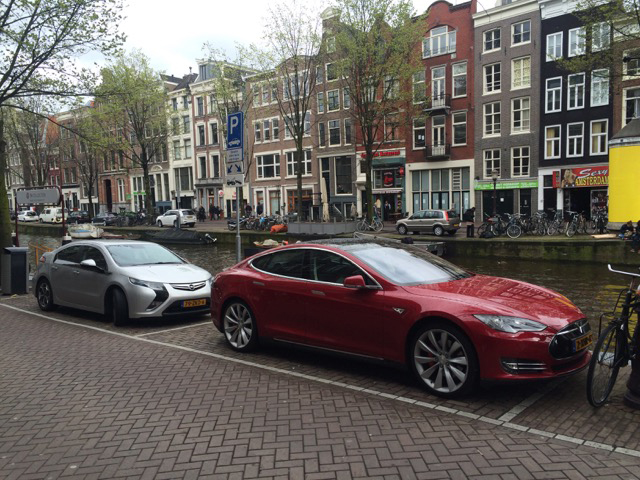Blog
Things are electric in Amsterdam
Everyone knows that Amsterdam is a uniquely liberated place. Fresh off a trip to the Netherlands’ capital, I can say it’s downright electric. The Netherlands is hosting the European Union Presidency in Amsterdam, decarbonizing transportation is a hot topic on the European agenda, and the Dutch are going all in on the transition to electric vehicles.
What do I mean by “going all in”? The Dutch political leadership is pushing at all levels, and they appear to be implementing nearly every electric vehicle promotion action that researchers like us have identified as best practices for e-mobility.
The Netherlands has set a target that all new passenger vehicle sales are to be zero-emission capable vehicles by 2035. Some policymakers are even unsatisfied with that: the lower house of the Parliament has called for a ban on gasoline and diesel vehicles in the Netherlands by 2025. Along with California, Norway and others, the Netherlands is one of the founding partners of the ZEV Alliance, in which members collaborate, share best-practice learning, and in general work to build greater economies of scale and accelerate the transition to a global electric vehicle market. The city of Amsterdam aims to become the first emission-free city in Europe by implementing a wide portfolio of pro-electric vehicle measures. Those include a plan for a full shift to all electric buses by 2025 and an agreement for a zero-emission taxi fleet by 2025.
And the Dutch are backing all this up with targeted actions. A national system of fiscal incentives provides significant motivation for automakers to deploy, and consumers to purchase or lease, electric vehicles. Exemptions from national taxes make average electric vehicles comparable in cost to their conventional counterparts (for an earlier take on this, see here). And the country has managed to create a nearly universally interoperable payment system for EV charging stations, greatly reducing confusion and frustration when electric vehicle users are seeking a public plug for a quick recharge.
What does the Netherlands have to show for this political leadership? In Amsterdam, the effects are visible everywhere. Most of the taxis I saw at the airport were Tesla Model S (part of taxi fleet of 167 such Teslas). Nissan also has 170 electric Leaf and eNV200’s in circulation, and electric vehicles are given taxi line preference at Amsterdam Central Station. And you’ll see preferential electric vehicle parking and chargers everywhere, not only as you walk the busier streets but on the cobblestoned streets running along the canals as well. The Netherlands is among the world leaders in electric vehicle charging infrastructure per capita, and Amsterdam will more than double its number of charging points from 2015 to 2018, up to 4,000 units. For perspective: Amsterdam’s population is about the same as that of Columbus, Ohio, or Indianapolis, Indiana, which have 60–120 public chargers. And that infrastructure is placed where it’s needed: the public chargers are located where drivers are requesting their installation. In addition, the city uses its procurement policies to steer local deliveries toward low-emission vehicles and also aims to phase in further restrictions for its low-emission vehicle zone in the urban core through 2018.

Not only are electric vehicles in evidence everywhere you look in Amsterdam, but the national data from 2015 show that the work is also paying off on a grander scale. In 2015, approximately 10% of new cars sold in the Netherlands were plug-in electrics (see figure below). In terms of national sales share of electric vehicles, this is second only to Norway, the perennial global leader with over 20% in 2015.
Of course, this isn’t to suggest that the electric vehicle market in the Netherlands doesn’t still face challenges to its development. Because so many households in Amsterdam (and other cities) are multi-unit dwellings without garages, sufficient public charging is even more important there than in other markets. Also, the Dutch are acutely aware of the dangers of plug-in hybrid electric vehicles that aren’t being plugged in enough. This is an especially important question in the Netherlands because it has such a high proportion of plug-in hybrid vehicles compared to full battery electric vehicles (see figure).
But caveats notwithstanding, there are few places on the planet where you can observe the transition to an electric vehicle fleet more clearly than here. Amsterdam is on its way toward becoming liberated from one more thing: combustion automobiles.

